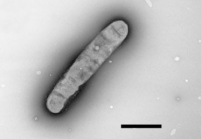WoRMS taxon details
Nitratifractor salsuginis Nakagawa et al., 2005
1261849 (urn:lsid:marinespecies.org:taxname:1261849)
accepted
Species
marine
recent only
Nakagawa, S.; Takai, K.; Inagaki, F.; Horikoshi, K.; Sako, Y. (2005). Nitratiruptor tergarcus gen. nov., sp. nov. and Nitratifractor salsuginis gen. nov., sp. nov., nitrate-reducing chemolithoautotrophs of the -Proteobacteria isolated from a deep-sea hydrothermal system in the Mid-Okinawa Trough. <em>INTERNATIONAL JOURNAL OF SYSTEMATIC AND EVOLUTIONARY MICROBIOLOGY.</em> 55(2): 925-933., available online at https://doi.org/10.1099/ijs.0.63480-0 [details]
Type locality contained in Okinawa Trough
type locality contained in Okinawa Trough [details]
Description Cells have a mean length of 2.5 mm and a width of approximately 0.6 mm. The temperature range for growth
is 28–40 uC...
Etymology sal.su'gi.nis. L. gen. fem. n. salsuginis from brine
is 28–40 uC...
Description Cells have a mean length of 2.5 mm and a width of approximately 0.6 mm. The temperature range for growth
is 28–40 uC (optimum, 37 uC). The pH range for growth is 5.6–7.6 (optimum, pH 7.0). NaCl in the concentration
range 15–35 g l2l is an absolute growth requirement; optimum growth occurs at 30 g NaCl l2l. Strictly chemolithoautotrophic
growth occurs with molecular hydrogen as an electron donor and with oxygen or nitrate as an
electron acceptor. Nitrate is reduced to N2. Major cellular fatty acids are C18 : 1 (42.3 %), C16 : 1 (30.7%) and C16 : 0
(24.3 %). The G+C content of genomic DNA is 35?5 mol% (HPLC). The type strain, E9I37-1T (=JCM 12458T=DSM 16511T),
was isolated from the Iheya North hydrothermal field inthe Mid-Okinawa Trough, Japan [details]
is 28–40 uC (optimum, 37 uC). The pH range for growth is 5.6–7.6 (optimum, pH 7.0). NaCl in the concentration
range 15–35 g l2l is an absolute growth requirement; optimum growth occurs at 30 g NaCl l2l. Strictly chemolithoautotrophic
growth occurs with molecular hydrogen as an electron donor and with oxygen or nitrate as an
electron acceptor. Nitrate is reduced to N2. Major cellular fatty acids are C18 : 1 (42.3 %), C16 : 1 (30.7%) and C16 : 0
(24.3 %). The G+C content of genomic DNA is 35?5 mol% (HPLC). The type strain, E9I37-1T (=JCM 12458T=DSM 16511T),
was isolated from the Iheya North hydrothermal field inthe Mid-Okinawa Trough, Japan [details]
Etymology sal.su'gi.nis. L. gen. fem. n. salsuginis from brine
Etymology sal.su'gi.nis. L. gen. fem. n. salsuginis from brine [details]
WoRMS (2024). Nitratifractor salsuginis Nakagawa et al., 2005. Accessed at: https://www.marinespecies.org/aphia.php?p=taxdetails&id=1261849 on 2024-06-01
Date
action
by
![]() The webpage text is licensed under a Creative Commons Attribution 4.0 License
The webpage text is licensed under a Creative Commons Attribution 4.0 License
original description
Nakagawa, S.; Takai, K.; Inagaki, F.; Horikoshi, K.; Sako, Y. (2005). Nitratiruptor tergarcus gen. nov., sp. nov. and Nitratifractor salsuginis gen. nov., sp. nov., nitrate-reducing chemolithoautotrophs of the -Proteobacteria isolated from a deep-sea hydrothermal system in the Mid-Okinawa Trough. <em>INTERNATIONAL JOURNAL OF SYSTEMATIC AND EVOLUTIONARY MICROBIOLOGY.</em> 55(2): 925-933., available online at https://doi.org/10.1099/ijs.0.63480-0 [details]
context source (Deepsea) Nakagawa, S.; Takai, K.; Inagaki, F.; Horikoshi, K.; Sako, Y. (2005). Nitratiruptor tergarcus gen. nov., sp. nov. and Nitratifractor salsuginis gen. nov., sp. nov., nitrate-reducing chemolithoautotrophs of the -Proteobacteria isolated from a deep-sea hydrothermal system in the Mid-Okinawa Trough. <em>INTERNATIONAL JOURNAL OF SYSTEMATIC AND EVOLUTIONARY MICROBIOLOGY.</em> 55(2): 925-933., available online at https://doi.org/10.1099/ijs.0.63480-0 [details]
context source (Deepsea) Nakagawa, S.; Takai, K.; Inagaki, F.; Horikoshi, K.; Sako, Y. (2005). Nitratiruptor tergarcus gen. nov., sp. nov. and Nitratifractor salsuginis gen. nov., sp. nov., nitrate-reducing chemolithoautotrophs of the -Proteobacteria isolated from a deep-sea hydrothermal system in the Mid-Okinawa Trough. <em>INTERNATIONAL JOURNAL OF SYSTEMATIC AND EVOLUTIONARY MICROBIOLOGY.</em> 55(2): 925-933., available online at https://doi.org/10.1099/ijs.0.63480-0 [details]
 Present
Present  Present in aphia/obis/gbif/idigbio
Present in aphia/obis/gbif/idigbio  Inaccurate
Inaccurate  Introduced: alien
Introduced: alien  Containing type locality
Containing type locality
From other sources
Description Cells have a mean length of 2.5 mm and a width of approximately 0.6 mm. The temperature range for growthis 28–40 uC (optimum, 37 uC). The pH range for growth is 5.6–7.6 (optimum, pH 7.0). NaCl in the concentration
range 15–35 g l2l is an absolute growth requirement; optimum growth occurs at 30 g NaCl l2l. Strictly chemolithoautotrophic
growth occurs with molecular hydrogen as an electron donor and with oxygen or nitrate as an
electron acceptor. Nitrate is reduced to N2. Major cellular fatty acids are C18 : 1 (42.3 %), C16 : 1 (30.7%) and C16 : 0
(24.3 %). The G+C content of genomic DNA is 35?5 mol% (HPLC). The type strain, E9I37-1T (=JCM 12458T=DSM 16511T),
was isolated from the Iheya North hydrothermal field inthe Mid-Okinawa Trough, Japan [details]
Etymology sal.su'gi.nis. L. gen. fem. n. salsuginis from brine [details]

